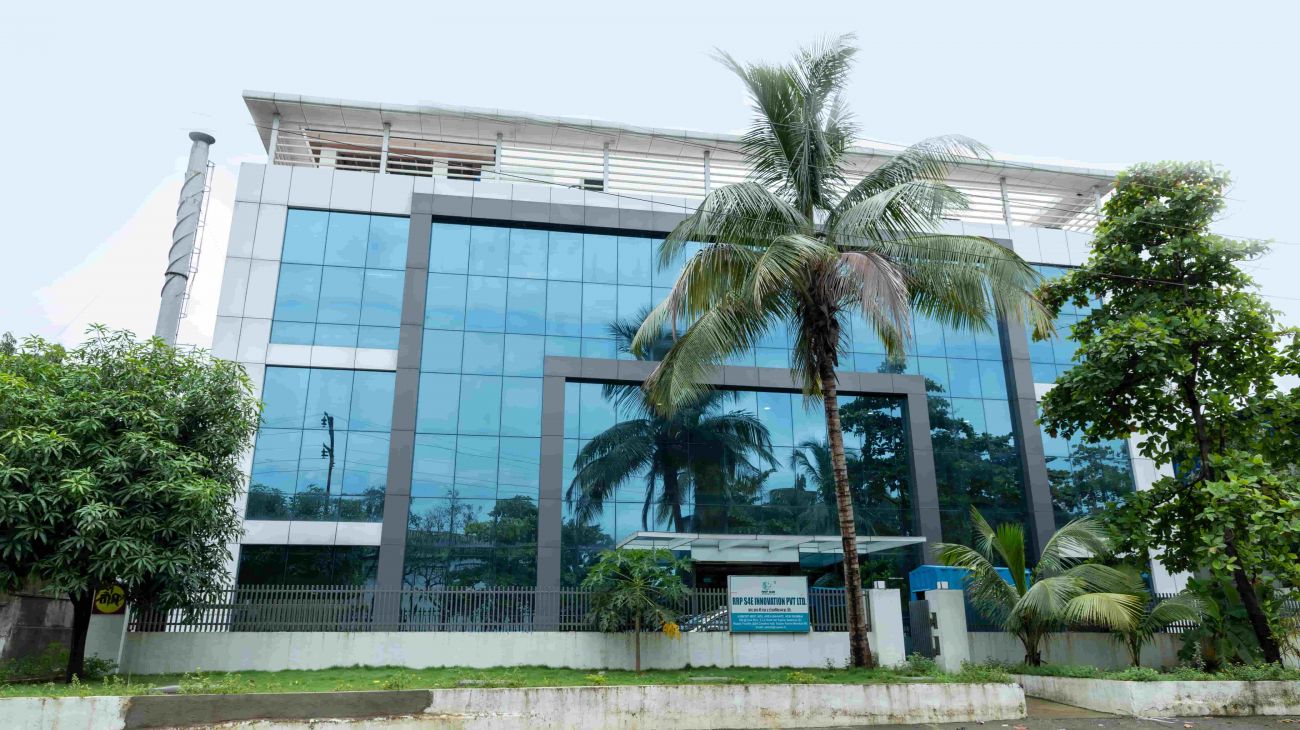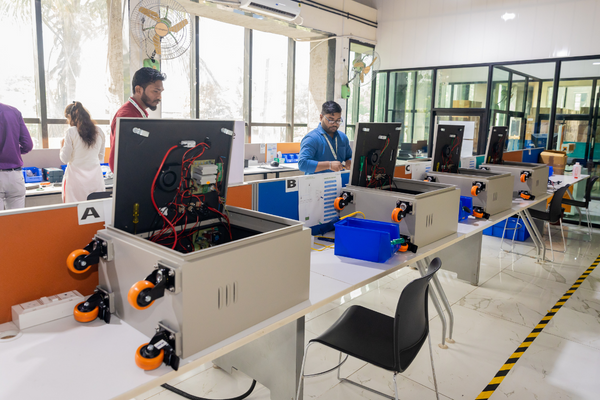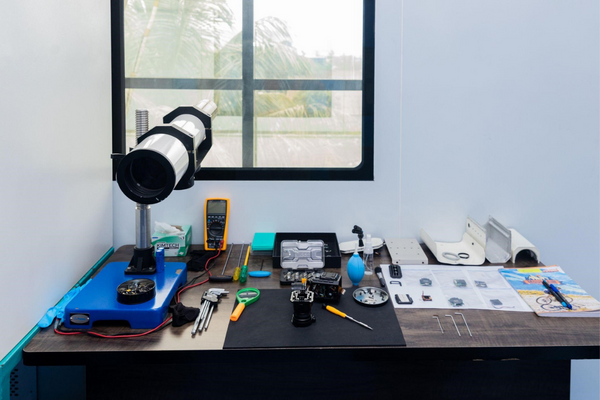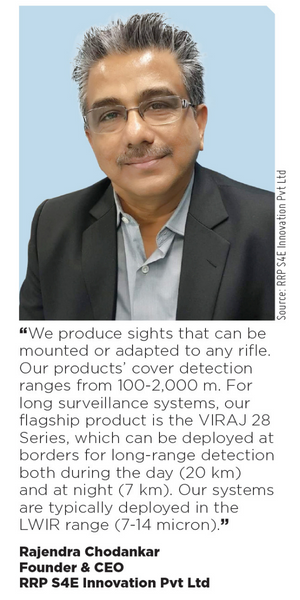SUCCESS THROUGH INNOVATION

A leading technology consulting firm with design strengths in electro-optic products and systems, RRP S4E Innovation Pvt Ltd has excelled despite the pandemic and the subsequent economic changes. Bolstered by Government initiatives and academic partnerships, the company finds itself
better equipped to provide innovative, user-friendly, and cost-effective solutions to all consumer challenges.
RRP S4E Innovation Pvt Ltd is the most innovative and fastest-growing company in the thermal space that found its footing with the introduction of the ‘Make in India’ initiative. “We are all aware that India is fully equipped to build and deliver components and modules, but the challenge has been to turn them into a final product. The ‘Make in India’ initiative is now the solution, as it allows us to acquire design knowledge by virtue of the initiative,” says Rajendra Chodankar, Founder & CEO, RRP S4E Innovation Pvt Ltd.
"Our journey began in 1990, and the next three decades brought mixed fortunes, with challenges that gave us the courage to think big. One significant achievement was the setting up of a unique Nano Machining facility that let us produce mechanical components with over one-micron tolerance and a three-nanometer surface finish,” he shares.
Understanding company products
The company’s offerings are divided into two categories: Electro-optics and Healthcare. The Electro-optics domain’s main products are:
- Day Sights, which are mounted on rifles with target detection of up to 250 m;
- Thermal sights with target detection of up to 2 km;
- Border Protection and Surveillance Systems for extended detection range up to 20 km during the day and 7 km at night;
- Handheld systems.
In Healthcare, the company has developed an Advanced Air Purifier System called Aerem 100. It is fully indigenized and claimed to be highly effective in killing viruses and bacteria in the air and also disintegrating amino acid chains. The product has received approval from ICMR, TUV, CE, European, and UK Academic Labs.
“When we commenced our journey, it was exclusively for military and related applications, but today, the products are being deployed for multiple commercial applications,” says Chodankar.
Commercial applications of electro-optics include Face Recognition, Integrated Highway and Toll Locations, Intruder Management Systems, Surveillance Monitoring in Commercial Malls and Public Places, etc.
In the military domain, he elaborates, “We produce sights that can be mounted or adapted to any rifle, which actually form the eye of the soldier. Our products cover detection range from 100-2,000 m. For long surveillance systems, our flagship product is the VIRAJ 28 Series, which can be deployed at borders for long-range detection both during the day (20 km) and at night (7 km). Our systems are typically deployed in the LWIR range (7-14 micron).”
The company has recently diversified by improving the software and its algorithms to deploy the product for drone detection. “We appear to have received some excellent results. Our systems are now configured with a tracking speed of 80 m/s, which is comparable to RF/Radar anti-drone systems,” he reveals.
Regarding the company’s Thermal Imaging Cameras, he explains that the camera works on the principle of the lens absorbing the heat of the target, which is then processed by the sensor, also known as the Thermal Core or Focal Plane Array (FPA). The core has image processing capabilities, and the image formed is then converted by the OLED into an image that can be viewed by the eyes.

Electro-optics and its potential
Chodankar believes that the 3rd generation of Electro-optics is the future and that its market has the potential to reach US$ 1 billion by 2024-25. He notes that there have been many advances in image detection at extended distances, and the introduction of fusion systems allows users to see through a glass, which was previously restricted by thermal sights. According to him, Electro-optics is not just applicable to the military sector; most systems are currently being used in commercial applications in order to be cost-effective.
Pointing to the market’s intense competition and the segment’s quick development, he states, “The global military electro-optical and infrared systems market is projected to register a CAGR of 2.51 percent, reaching US$ 9,314.13 million by 2026. By platform, the air-based segment held the largest market share (54.26 percent) in 2020. The sea-based segment will have the highest CAGR (2.67 percent) during the forecast period.” He claims that due to this segment’s profitability with the latest technologies and the ability for players to share technology, new entrants are also entering it.
“Simultaneously, various design challenges, technological constraints, supply chain risks, the evolving global crisis, and unprecedented factors, like the advent of the COVID-19 pandemic, could affect the market negatively in the near future,” he says. “Therefore, growing military budgets of countries across the globe, R&D in advanced infrared imaging technologies, developing sensors that can provide high-resolution images, and the need for better sensors to enhance situational awareness of the military personnel in the battle space are some of the major driving factors of this market.”
Helping make significant progress
As per Chodankar, the Prime Minister’s ‘Make in India’ strategy for Electro-optics is the best thing that could have happened to any entrepreneur. “We thank Hon’ble Prime Minister, Shri Narendra Modi, for having introduced the ‘Make in India’ initiative and deployed teams to ensure that full justice is done. The developments and products show the impact of ‘AatmaNirbhar Bharat’ and ‘Make in India’.” He claims that India is now exporting products in numerous sectors, due to Government policies under which MSME and other corporate houses can obtain Transfer of Technology (TOT) for designs.
Speaking on the collaboration with IIT, Chodankar outlines, “Our journey with IIT has been enriching and encouraging as it was a classic example of a viable Public Partnership Model.” Coining it a mutual benefit gained during their journey to build a thermal core that could be deployed on a thermal site or a surveillance system, he reveals, “The sensor was imported, and IIT worked on the image processing capabilities, which have been their expertise and established beyond doubt. We developed the 640 × 480 core with a 17-micron pixel pitch in one more domain, wherein the contribution of IIT was significant: testing expertise and the infrastructure.”
The company has a 100 percent ‘Made in India’ product in the reflex sights for daytime applications, which was also tested and tried by the user. However, the issue, he admits, is the construction of the thermal sensor, which restricts full implementation, but he confirms that the product may be developed in India in another three years. “We started the ‘Made in India’ journey at 10 percent and have now reached 60 percent in three years, which is quite impressive,” he says. “For example, our Aerem 100 is 100 percent indigenous, demonstrating the benefits this platform has provided to entrepreneurs, MSMEs, and others.”


Catering to the Indian Army and society
The company has spent over a year attempting to comprehend the requirements and challenges of the Indian Army and the Indian Government. “We built a product on a no-cost, no-commitment (NCNC) basis and had to change it a couple of times after extensive trials at various high levels,” Chodankar says. “We were subsequently awarded the contract to supply 44 systems through a bidding process, but we were well placed because we had a fair idea of the application due to our previous journey.”
As the applications gain popularity, the company improves and adapts the systems and upgrades the products to meet the detection ranges. “Our existing products can be deployed to detect targets in one day up to 20 km and 10 km at night, but the major problems have been target detections at 50 km, which is indeed a huge quantum jump in technology,” he explains. “We’re in touch with a couple of global technology providers and plan to have a product by 2023.”
The startup also produced fever detection systems to fulfill its growing demand at the onslaught of COVID-19. This is where the electro-optical (EO) sensors played a significant role. With the development of the new software, the company was able to release the product in record time because the hardware was ready and all it needed was to deploy the software.
“Thermal cameras are the ideal solution for fever detection during this COVID-19 pandemic scenario. You can eliminate
the risks involved in direct physical contact for recording temperature and ensure the safety of your people. The CCTV cameras are powered by advanced AI technology and body temperature measurement technology to maximize the efficiency of your security systems,” he explains.
The company’s main products in the electro-optics domain are: Day Sights mounted on rifles with a target detection range of up to 250 m, Thermal Sights with a target detection range of up to 2 km, Border Protection and Surveillance Systems for extended detection ranges of up to 20 km during the day and 7 km at night, and Handheld Systems.
RRP S4E Innovation has developed an Advanced Air Purifier system, the Aerem100, which is fully indigenized and effective at killing all the viruses and bacteria in the air and also disintegrating amino acid chains.

Sovan Tudu
Senior Sub-editor
Magic Wand Media Inc
Sovan.tudu@magicwandmedia.in



 Facebook
Facebook.png) Twitter
Twitter Linkedin
Linkedin Subscribe
Subscribe